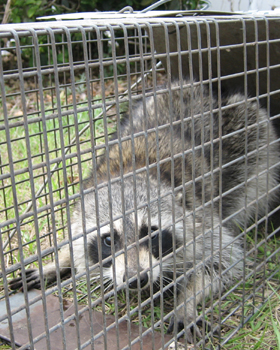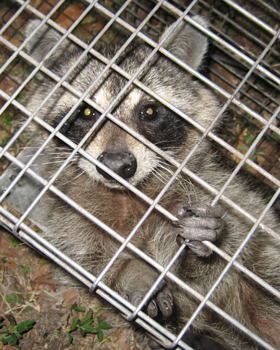Is live cage trapping effective? In some cases, it can be, and I'll discuss that below. But in many cases, using a live cage trap does not solve the raccoon problem. In many instances,
it only creates more problems! These are the four primary problems with live cage trapping:
1) In many states it is illegal to transport and relocate trapped raccoons. They must be killed.
2) Relocated raccoons often do not survive. Raccoons grow up learning a specific territory, but can falter in a new one, or be outcompeted or driven out by existing animals.
3) For much of the year, an adult female raccoon is taking care of a litter of young raccoons in the area. If you remove the female, the orphaned young will surely starve to death. Not very humane!
4) Trapping and removal is almost always a temporary solution, one that does not address why a raccoon is causing a confliuct in an area. You remove one raccoon, but more will come in the future.
Also: when cage trapping, statistics show that over 50% of the time, a non-target animal is caught, such as a stray cat, pet cat, skunk, etc. Animals can die in cage traps due to fear and stress, dehydration, or
heat stroke if a trap is left in the sun. Be aware of these risks!
Is it legal for me to trap a raccoon myself? In many states yes, so long as you euthanize the animal on the spot. Read more about killing raccoons here. In many states it is not
legal to transport and relocate raccoons. This is often because of laws regaring Rabies Vector Species (RVS), or animals that could be rabid. Some states do allow trapping and relocation, and some states do not allow
any trapping without a permit. You can find the rules in your state by checking the locations page in your state.
After I catch one, what do I do with it? You have to decide to obey your state law, of course. Many people don't, simply driving the animal to "the woods" to let it go. If you want to kill the raccoon, you
will have to do so, and hopefully in a humane manner (see the "killing raccoons" page linked above). Or you can likely take the animal to the county animal services, where they will euthanize it in a humane manner. If you do
relocate it, and want to be sure it will not return, bring it at least 10 miles away. If your situation is that a raccoon is entering a house, under a shed, etc, you can also hold it in the cage while you perform repairs to prevent
the animal from going back in the structure, and then release it on site. Beware, of course, of the possibility of a nest of baby raccoons in the structure, in which case the female raccoon will desperately claw her way back
in, and that failing, the young will starve to death.
Trapping a raccoon in a live trap is humane, right? Many people think that catching a raccoon in a live cage trap, like the "Havahart" brand is the humane and responsible thing to do. But as discussed, you
are likely killing the animal, and stand a chance of killing a nearby nest of young as well.
When is trapping the right approach? We would like to say "never", but in some cases a raccoon learns a bad behavior, and the habitat or situation cannot be modified. For example, a raccoon is consistently taking food from restaurant patrons
or causing a public health threat. Or a raccoon is causing property damage that cannot be prevented, like rolling up a large area of freshly laid sod. There are many possible reasons in which a property owner will decide that the only solution is to physically
remove specific raccoons that have made undesirable behavior a habit. With luck, a new raccoon in the area won't just start doing the same thing. But nature has its way, and it's likely that the same problem will happen again, in time.
Okay, I want to trap it myself: - Check state laws first, to see if it's legal. We will provide trapping advivce below. But in 20 years we have seen it all, and amateurs almost always make many terrible mistakes. It may seem simple to get a large cage trap, bait it with food, and wait. But most first-timers make mistakes such as leaving the cage in the sun, causing heat stroke come daylight, or leaving the cage in an
area where the raccoon will reach out and dig or damage nearby wires or property, or failure to stabilize the trap base, set correct pan tension, and on and on. Most do-it-yourself attempts fail, and are illegal, and usually cause more frustration for the
homeowner and suffering for the raccoons than would happen with a professional. Also, amateurs often make the problem worse when their ineffective sets cause trap failures, and subsequent "cage-shy" raccoons, which can become a problem to deal with.
Raccoon trapping tips and strategies
What kind of trap should I use? - A large steel cage trap, made for raccoons. Usually at least size 32" long, 12" high, 10" wide, such as the Havahart 1079 or the Tomahawk 608SS. Most traps are made of heavy duty steel wire, but some are solid-walled
plastic material. Most have a door with a spring mechanism of some sort, and a trip pan near the back that triggers the door to shut. There are single-door and double door varieties. With most raccoons,
the exact model of trap does not matter. However, if you have a cage-shy raccoon that has been trapped before and now avoids a trap, a different model, or a safer-looking double door model may achieve success.
What kind of bait catches raccoons? - Marshmallows, or white bread. Raccoons are omnivores, and will eat almost anything. That said, like humans, they prefer high-calorie sugary or fatty or meaty foods. You can certainly
catch raccoons with dog food or cat food, both wet or dry, or any other type of meat bait, but one of the problems with cage trapping in general is the likelihood of catching non-target animals. More often than not, you'll catch a non-target
animal, such as a stray cat, opossum, skunk, or even a neighbor's pet outdoor cat! Meat baits tend to attract cats, skunks, and oppossums. For this reason, we highly advise the use of marshmallows or bread for raccoons, which work very well.
In truth, the type of bait isn't nearly as important as the overall trap set, including location, pan tension, stability of trap, acceptability of trap floor, size and type of trap, and so on. Even though it may seem as simple as "buy a trap,
set it, throw in some bait, and wait" trapping is an art, one which amatuers tend to get wrong more often than not.
We do offer help in some areas, such as
Birmingham,
Huntsville,
Montgomery,
Phoenix,
Los Angeles,
Oakland,
Riverside,
Sacramento,
San Diego,
San Francisco,
San Jose.
For effective ways to solve a raccoon problem yourself, or to find local help, click the below buttons:




